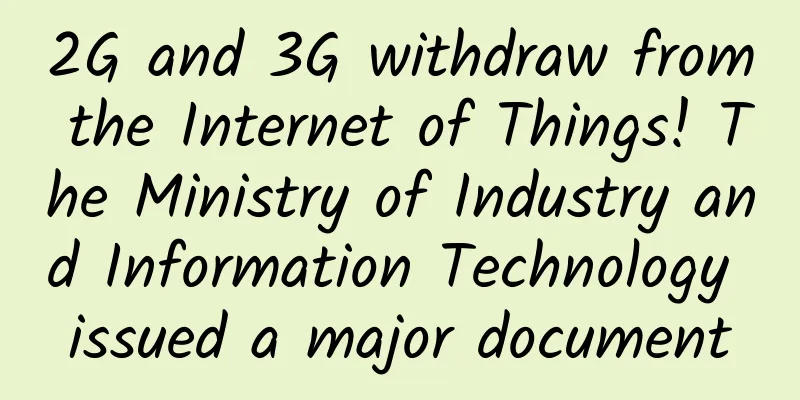2G and 3G withdraw from the Internet of Things! The Ministry of Industry and Information Technology issued a major document

|
On May 7, the Ministry of Industry and Information Technology issued the "Notice on Deeply Promoting the Comprehensive Development of Mobile Internet of Things", guiding new IoT terminals to gradually withdraw from 2G or 3G networks and migrate to NB-IoT and 4G (LTE Cat1); and plans to increase the number of mobile Internet of Things connections to 1.2 billion by the end of this year, achieving universal coverage of the main urban areas of cities at or above the county level, and in-depth coverage of key areas.
The "Notice" clearly proposes to guide new IoT terminals to no longer use 2G/3G networks, and to promote the migration of existing 2G/3G IoT services to NB-IoT/4G (Cat1)/5G networks. The main contents of the notice are as follows: To the competent departments of industry and information technology of all provinces, autonomous regions, municipalities directly under the Central Government and the Xinjiang Production and Construction Corps, the communications administration bureaus of all provinces, autonomous regions, municipalities directly under the Central Government, and relevant enterprises: Mobile Internet of Things (IoT technologies and applications based on cellular mobile communication networks) is an important part of the new infrastructure. In order to implement the decisions and arrangements of the CPC Central Committee and the State Council on accelerating the construction and application of new infrastructure such as 5G and the Internet of Things, accelerate the digital transformation of traditional industries, and strongly support the construction of a strong manufacturing country and a strong network country, the following matters are hereby notified on promoting the comprehensive development of mobile Internet of Things: 1. Main Objectives Accurately grasp the evolution trend of global mobile Internet of Things technology standards and industrial structure, promote the migration and network transfer of 2G/3G Internet of Things services, establish a comprehensive mobile Internet of Things ecosystem with coordinated development of NB-IoT (narrowband Internet of Things), 4G (including LTE-Cat1, i.e. 4G network of rate category 1) and 5G, and on the basis of deepening 4G network coverage and accelerating 5G network construction, use NB-IoT to meet most low-speed scenario requirements, use LTE-Cat1 (hereinafter referred to as Cat1) to meet medium-speed Internet of Things and voice requirements, and use 5G technology to meet higher-speed and low-latency networking requirements. By the end of 2020, the NB-IoT network will achieve universal coverage in the main urban areas of cities at the county level and above, and in-depth coverage in key areas; the number of mobile IoT connections will reach 1.2 billion; the price of NB-IoT modules will be pushed to converge with that of 2G modules, and new IoT terminals will be guided to migrate to NB-IoT and Cat1; a number of NB-IoT application benchmark projects and NB-IoT application scenarios with a scale of millions of connections will be created. II. Key Tasks (1) Accelerate the construction of mobile Internet of Things networks. Accelerate the construction of 5G networks, continue to deepen 4G network coverage, and support the development of Cat1; further increase the deployment of NB-IoT networks, build new NB-IoT base stations as needed, achieve universal coverage in urban areas at the county level and above, and achieve in-depth coverage for application scenarios such as indoors, transportation networks, underground pipelines, and modern agricultural demonstration areas; focus on network operation and maintenance, monitoring, and optimization, and improve network service levels. (2) Strengthen research on mobile Internet of Things standards and technologies. 1. Formulate standards for the integration of mobile Internet of Things and vertical industries. Promote the inclusion of NB-IoT standards into the ITU IMT-2020 5G standards; promote the formulation and implementation of technical standards and interoperability standards for mobile Internet of Things terminals and platforms in key areas such as smart homes, smart agriculture, industrial manufacturing, energy meters, fire smoke detectors, logistics tracking, and financial payments, and improve the level of industry application standardization. 2. Conduct research on key technologies of mobile Internet of Things. Aiming at the application environments and business needs of different vertical industries, focus on strengthening research on emerging key technologies such as network slicing, edge computing, high-precision positioning, smart sensing, security chips, miniaturized low-power smart meters, and cross-domain collaboration, and conduct related experiments. (3) Enhance the breadth and depth of mobile Internet of Things applications. 1. Promote the application and development of mobile Internet of Things. Promote the innovative development of mobile Internet of Things in the three major directions of industrial digitalization, intelligent governance, and smart life. In terms of industrial digitalization, deepen the application of mobile Internet of Things in industrial manufacturing, warehousing and logistics, smart agriculture, smart medical care and other fields, promote the collection of data from equipment networking, and improve production efficiency. In terms of intelligent governance, take energy meters, fire smoke detectors, public facilities management, environmental monitoring and other fields as entry points to help continuously improve public service capabilities, enhance urban resilience and the ability to respond to emergencies. In terms of smart life, promote the application of mobile Internet of Things technology in smart homes, wearable devices, child and elderly care, pet tracking and other products. 2. Create a benchmark project for the mobile Internet of Things. Build a mobile Internet of Things resource library, collect and store innovation and application practice cases, and provide services such as communication and promotion, and matching investment and financing needs; select a number of best cases from the resource library to create a benchmark project for the mobile Internet of Things, and drive the innovative development of millions of connected application scenarios through benchmark projects; further expand the applicable scenarios of mobile Internet of Things technology, and expand new products, new formats and new models based on mobile Internet of Things technology. (4) Build a high-quality industrial development system. 1. Improve the mobile Internet of Things industry chain. Encourage local governments to set up special support and innovation funds to support the research and development of NB-IoT and Cat1 dedicated chips, modules, equipment and other products, improve chip research and development and production and manufacturing capabilities, and meet the needs of large-scale shipments; build a complete NB-IoT industry chain, provide diversified products and application systems that meet market demand; further reduce the cost of NB-IoT modules, and reduce it to the same level as 2G modules in 2020; increase the research and development of Cat1 chips and modules, promote the reduction of module costs, and promote large-scale applications. 2. Accelerate the construction of a service platform for cloud-pipe-edge-end collaboration. Support basic telecommunications companies to build a mobile Internet of Things connection management platform, strengthen network capability opening, support rapid access to IoT sensing devices, and support massive concurrent application scenarios; guide industry application companies to build vertical industry application platforms with intelligent equipment integration, intelligent equipment and data management, and intelligent system operation and maintenance, and gradually form a mobile Internet of Things platform system, further reduce the development cost and connection complexity of mobile Internet of Things devices, and meet the application needs of complex scenarios. Encourage capable companies to build open laboratories to provide testing, verification, and development support services for small and medium-sized enterprises. 3. Regulate the development order of the mobile Internet of Things industry. Support the implementation of mobile Internet of Things network quality assessment and testing, promote network service quality to meet user needs, and promote the improvement of the quality and efficiency of mobile Internet of Things network services. Give full play to the role of social service supervision, promptly and properly handle service problems reported by users, and encourage enterprises to continuously improve service quality. Encourage enterprises to formulate long-term development goals, strengthen business innovation and differentiated development, regulate market behavior, and create a good competitive development atmosphere. 4. Support mobile communication resale enterprises to carry out mobile Internet of Things business. Give full play to the fast and flexible response mechanism and cross-industry resource capabilities of mobile communication resale enterprises, carry out mobile Internet of Things business innovation in vertical industry application fields such as industrial Internet and Internet of Vehicles, and promote integrated development with the real economy. (V) Establish and improve a mobile Internet of Things security assurance system. 1. Strengthen the security protection and data protection of the mobile Internet of Things. Establish a network security management mechanism for the mobile Internet of Things, and clarify the security responsibilities and obligations of different entities such as operating companies, product and service providers. Strengthen the security detection of mobile Internet of Things network facilities, and strengthen the guidance and specifications for the collection, reporting and repair of network security vulnerabilities. Support the research and development of core network security technologies through pilot demonstrations, industrial Internet innovation and development projects, etc. Carry out security evaluation of key mobile Internet of Things products, and accelerate the formation of products, services and solutions that match the scene characteristics and security needs of the mobile Internet of Things. Strengthen the protection of user information, personal privacy and important data of the mobile Internet of Things. 2. Strengthen the basic security of mobile Internet of Things. Establish a mobile Internet of Things security standard framework, and formulate a series of hierarchical and classified security management standards for key links such as Internet of Things cards, terminals, and gateways. Encourage enterprises and research institutions to increase research and application of security technical means such as trusted authentication technology for mobile Internet of Things terminals and blockchain traceability. Accelerate the construction of mobile Internet of Things security supervision technical means, and enhance real-time monitoring capabilities such as security situation awareness, card-end management, and risk warning. III. Safeguard Measures (I) Formulate a development roadmap. In line with the laws of mobile communication technology changes, industry development trends and the requirements for efficient resource utilization, NB-IoT and Cat1 will work together to take over 2G/3G IoT connections and improve spectrum utilization efficiency. While ensuring the network service level of existing IoT terminals, guide new IoT terminals to stop using 2G/3G networks and promote the migration of existing 2G/3G IoT services to NB-IoT/4G (Cat1)/5G networks. (II) Conduct development level assessment. Establish a mobile Internet of Things development index model (Appendix), improve data statistics and information collection mechanisms, unify data statistics, track and monitor the basic situation of mobile Internet of Things industry development, and compile a mobile Internet of Things development report. Objectively measure and evaluate the level of development of the mobile Internet of Things industry, and fully stimulate the motivation of all parties to develop the mobile Internet of Things. (III) Strengthen infrastructure planning. Encourage local governments to comprehensively consider the needs of smart applications in the construction of industrial parks, smart cities, beautiful villages, urban roads and bridges, municipal pipe networks, integrated pipe corridors, transportation and logistics, green landscaping and other infrastructure, and prepare for the construction of mobile Internet of Things related facilities or reserve space in advance. (IV) Create an orderly market environment. Mobile Internet of Things companies should include Internet of Things services in the control system for nuisance calls and spam text messages, improve the monitoring, discovery and disposal mechanism for nuisance calls and spam text messages, strictly regulate the use of functions such as text messages and voice according to the functional restriction requirements of Internet of Things cards, and enable Internet of Things functions for users in accordance with the principle of "minimum necessary"; strengthen the supervision of mobile Internet of Things products entering the network, guide companies to launch various types of mobile Internet of Things terminal products in accordance with laws and regulations; strengthen supervision during and after the event, strengthen punishment for various illegal and irregular behaviors, and create a fair and good market environment. (V) Increase publicity and promotion efforts. Give full play to the demonstration, guidance and resource aggregation role of the National Internet of Things Industry Demonstration Base and the Mobile Internet of Things Industry Alliance, strengthen the publicity and promotion of excellent cases and benchmark projects of the Mobile Internet of Things, encourage local governments to combine smart cities, "Internet +" and "mass entrepreneurship" to promote work, strengthen the integration and innovation of the information and communication industry and vertical industries, and create a good policy environment. |
<<: A 200 billion market is in sight! 5G and smart agriculture are in love with each other
Recommend
RepriseHosting: Seattle dedicated servers starting from $27.97/month, free double memory, free bandwidth upgrade
RepriseHosting has updated some promotion informa...
The ultimate competition, the battle of the strong--Kunpeng Application Innovation Competition 2020. The Zhejiang Division Finals was successfully held
[51CTO.com original article] On August 21, the fi...
Dissecting an HTTP POST request incident
Author: Wei Ling, vivo Internet Server Team This ...
Traditional metropolitan area network architecture encounters bottlenecks and introducing NFV becomes an effective solution
With the rapid development of "Internet +&qu...
VirMach: $27.3/month-E3-1240v1/16GB/1TB/10TB/Los Angeles and other data centers
Last time, I shared the End of Life Plans series ...
How to avoid JS memory leaks?
[[416172]] Many developers may not care about whe...
Riverbed officially releases SaaS solutions for on- and off-cloud
The hottest word in the technology field in 2016 ...
Network monitoring tool! Don't miss these 7 free open source tools
Editor's note: In the real estate market, the...
DesiVPS: Los Angeles 1Gbps unlimited traffic VPS from $18.99 per year, India/Netherlands VPS from $20 per year
DesiVPS has released the latest promotional packa...
DiyVM: Japan/USA/Hong Kong CN2 VPS starting from 50 yuan per month, dual core/2G memory/50G SSD/5~200M bandwidth
Regular sharing, how about DiyVM? DiyVM is a Chin...
In the 5G era, how are operators doing in the government and enterprise market?
4G has just entered a stable development period, ...
7 IT reorganization mistakes to avoid
The way IT operates is changing constantly and ra...
Telenor launches 5G network in more than 60 locations in Bulgaria
Telecom operator Telenor has officially launched ...
Wi-Fi 7: Everything we know so far!
Over the past few decades, Wi-Fi has become the w...
What did Chinese operators show the world at the Winter Olympics?
This Winter Olympics is full of technological con...








![[cyberMonday] DediPath: VPS starts at $10 per year, dedicated server starts at $108/three months, 1Gbps unlimited traffic, multiple data centers in Los Angeles and other places](/upload/images/67cac00425403.webp)
